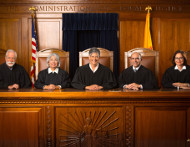1/12/2018
New Mexico Supreme Court Upholds Exaggerating CopThe inaccurate testimony of a New Mexico police officer can still be used to convict a motorist, state Supreme Court rules.

A police officer's exaggerated testimony can still be used to convict a motorist of a traffic offense, the New Mexico Supreme Court ruled last week. The justices overruled a three-judge panel of state Court of Appeals that had previously tossed the evidence gathered by Bloomfield Police Sergeant George Rascon, whose description of events of November 11, 2008, failed to match what the judges saw from dashboard camera footage. Sergeant Rascon said motorist Jennifer Martinez raced to the intersection of Sycamore and North Third.
"And at the four-way stop sign the vehicle just went past the stop sign completely into the lane of traffic, southbound lane of traffic," he testified. "She stepped on her brakes completely and she made a complete stop, but it was in the middle, in the lane of traffic."
At trial, the lower court judge expressed surprise when comparing the officer's version of events to the dashcam video.
"Alright, well you know after hearing Sergeant Rascon's testimony I was certainly confused as to why the defendant would file the motion to suppress because he made it sound very clear why, why he stopped and that there was reasonable suspicion, but I think it just goes to show you really need to review the video in every case," the trial judge observed. "And in this case after reviewing the video, I truly find the truth somewhere in between both positions. I certainly didn't see Sergeant Rascon's testimony that there was, she stopped in the middle of the intersection, I don't think that was the case."
The Court of Appeals found that the officer's stretching of the truth made his testimony unreliable, and the video itself made it impossible to determine whether there was a legitimate violation of law. Motorist Jennifer Martinez came to a full stop at that intersection, but there were no lines painted on the ground. From the angle of the video, the three-judge panel simply could not tell whether she stopped too far into the intersection, or not, so they threw out the case. The Supreme Court justices disagreed last week, insisting that the bar for reasonable suspicion was so low that it justified a traffic stop in this case and that the appellate court should have deferred to the trial judge.
"The district court resolved the parties' factual dispute in favor of the state, finding that defendant drove too far into the intersection before slamming on her brakes and coming to a stop," Justice Barbara J. Vigil wrote for the high court. "We conclude that the Court of Appeals erred by reweighing the evidence on appeal and failing to view the facts in the manner most favorable to the prevailing party."
A copy of the decision is available in a 100k PDF file at the source link below.


